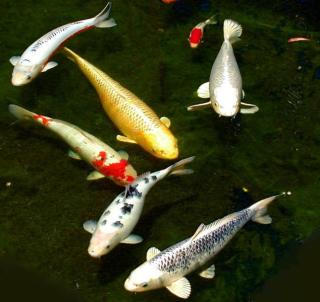In most ponds, plants are a definite feature. My original thoughts for this pond included a shallow area where I planned to grow plants. I'd read that koi are very disruptive with plants and so planned a 'lip' just under the surface of the water in order to deny the fish access to the planted section. Also, planting is a very good way to achieve excellent water quality, because the plants take up nutrients that are in the water - which in turn helps with algae, which is after these self-same nutrients. I figured that taking water from the shallow end would also create a natural flow through the pond that would tend to act as a natural filter bed - something like the reed-beds that are used for effluent treatment.
However, my final pond design was raised above the ground and so I couldn't do this. It would also have added complexity to the construction.
Water plants are almost all fast-growing. Planting in submerged containers aids regular maintenance (mostly cutting back growth etc). Be prepared to do regular maintenance on your planting.
Advice I was given about including plants in a koi pond includes:
Koi are voracious feeders and so will try to eat all of the plants. They will also disturb the soil and roots in order to get at the food.
If you want to have plants, put them in the pond when the koi are very small so that the plants are too big for the fish to eat.
As the koi disturb the roots, they will also tend to release the plating medium and this will cause murkiness in the water (or at least put a heavier load on your filtration.
Put layers of heavy pebbles on the top of your submerged pots to prevent the koi from gaining access to the roots/soil.
Lastly, I was told that eventually, most koi keepers give up with the plants because of all the extra work and hassle.
There are two big disadvantages through not having plants in the pond. The first is that there are no plants to take up the nitrates from the pond water, which means that any filtration has to work harder, and the second is that more light gets to the water, which encourages the growth of algae. Again, this means that water treatment has to work hard.

